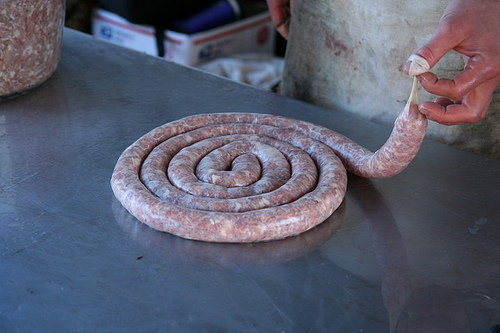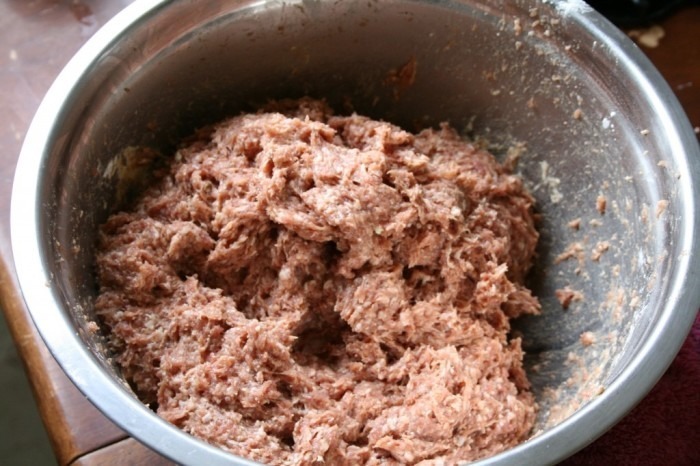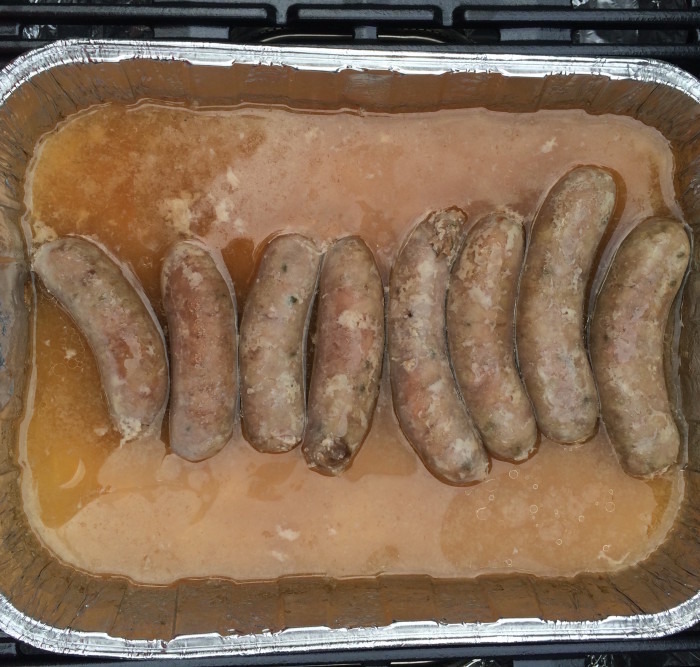Here's All You Need To Know About Making Sausage At Home

Ask 100 people how to make sausage and — just as when you ask for directions — you'll probably get 100 different responses. Those old sayings about "opinions" probably hold truer for sausage recipes than they do for a certain body part. Anyway, for our purposes, we're going to keep it simple and talk about fresh sausage. More specifically, fresh, sweet Italian sausage.
Sweet Italian sausage is the Tony Phillips of the fresh sausage world, which is to say it's the greatest utility player of the sausage world. And just like Tony's stints on the A's, Angels and Tigers — at every infield and outfield position, along with DH — your sweet Italian can be a star at breakfast, lunch or dinner. Buy it bulk (no casing) or break it out of its casing, add some fat (milk and butter), a bit of flour and you're a biscuit or two away from one of my favorite breakfasts. Add some peppers and onions and crusty bread, and I'm magically transported back to my youth, tailgating in the parking lot of Shea Stadium, awaiting another depressing Jets loss. Even simpler, add them to sauce, simmer all day and pour on top of your favorite pasta. There was never a house that didn't have some form of this on their stovetop in my youth. The possibilities are limitless.

Fresh sausage making can come off as an intimidating endeavor and a quick search of the web will reveal a host of communities full of experts, both real and self-professed. Here's the best advice I can give: Once you understand the relationship between salt, fat, meat and spice, do whatever you like. Flavor, texture and taste are realms of the subjective. Do you like a coarse grind or a fine grind? What kind of liquid do you want to use? You'll need that. It helps bind the meat and turn it from plain old ground meat into sausage. You can use water, juice, beer, wine, liquor or whatever you'd like.
And then there's the meat! It can be beef, pork, lamb, chicken, game or even fish. Keep in mind that some of these meats can be fairly lean and you'll need to add fat to them. I recommend pork, nature's most perfect fat! What kind of casings do you want to use? Natural, of course — I stay away from the synthetic stuff for this application, though you could also leave them uncased for a sausage patty. Then there's the question of equipment. You could have your butcher grind you the perfect 70/30 blend, which is what many agree to be the perfect meat-to-fat ratio. Or you could buy yourself that Kitchen Aid grinder attachment you've always wanted. Keep in mind that those attachments tend to heat your meat and fat considerably.
If there's one enemy of sausage making, it's heat. You'll want to keep your mixture as close to 32° F as possible — not quite frozen, but close. You'll want to buy yourself a scale, as that's the best way to get accurate measurements. A few grams over or under can dramatically change the way your sausages taste. And yes, I said grams: Do I really need to explain how the metric system is far superior here? If you choose to stuff, go the route of a manual stuffer. There are plenty of low-priced stuffers that'll get the job done. Stay away from the grinder attachment on the Kitchen Aid, which will heat things too much.

My sweet Italian recipe (see below) calls for very few spices, as I tend to write sausage recipes using as few extra ingredients as possible. I want spices to be an accompaniment to the great meat that I'm using. Just like I don't want bacon to taste like a slab of smoke, I want to taste pork if I'm cooking a pork sausage! Besides, spices are expensive — buy yourself quality meat with the money you've saved. Salt, pepper, garlic, oregano and anise (some prefer fennel) are all I use. Red wine helps to bind it all together. If those spices are dry, feel free to send them through the grinder with your meat. If you choose to use fresh spices, mix them by hand. You can certainly mix everything by hand, regardless of whether you grind your own or buy meat that is already ground from the butcher.
Talking someone through casing sausage is like talking someone through learning how to drive a manual transmission: It can't be done. You're going to grind some gears and stall...a lot. So stuff a stuffer, crank the crank and make lots of oddly shaped, air pocket-filled links until you don't anymore — that's the best way to learn. An ugly sausage is still a tasty sausage (if you've spiced it correctly). What I can do, once you've made your sausages, is help you cook them.
Since we're in peak grilling season, we'll keep things outside. If you've gone the uncased route, it's fairly simple — I like to cook patties with this much fat on a flat cooking surface. You don't want to lose all that flavor to flare-ups. So grab a cast-iron skillet or flat-top grate, and treat these just like you would a burger: medium heat for five to ten minutes on each side should do.
Things get a little more technical when we're cooking cased sausages. There are some serious pitfalls that we want to avoid. Cook cased sausages in natural casing over high heat, and they'll burst open. Cook them low and slow, and they'll shrivel up.

There's a way to avoid all of this and that's to give your sausages a nice little bath. Poaching sausages beforehand, either on your stovetop or directly on the grill, allows them to cook evenly without any of the problems mentioned above. You could use water, but beer definitely adds to the flavor. Once they've reached a temp of 145° F to 150° F, you can sear them off on your grill for that Instagram-ready photo. If you choose to do this entirely on your grill, and of course you do — it's July — here are a few hot tips. You'll want to set up a hot zone and a cool zone, and get yourself a deep tin to hold the sausages and your cooking liquid of choice. And why not toss in some additional flavor to that tin while you're cooking those sausages, peppers and onions, sauerkraut and broccoli rabe? Cook them slowly over the cool zone. Once they reach that 150° F mark, toss them on the hot zone for a quick char, crack a Victory Summer Love Ale and recline.
If you're ready to travel down that rabbit hole of sausage making in all its forms, here are a few places you should check out. You'll find much more detail and way more science. From Polish sausage makers with generations of knowledge to the newly initiated ready to put a new spin on classics, you'll want to listen to these folks.
Bryan Mayer's Sweet Italian Sausage Recipe
Ingredients
5 pounds coarse ground pork (70/30)
3 tablespoons salt (can use more or less, to taste)
1/2 tablespoon black pepper
3/4 tablespoon anise (or fennel)
1/4 tablespoon oregano
1/4 tablespoon garlic
For the liquid you can use all wine — red or white — or a mix of wine and water. You'll want to use one cup per five-pound batch of whatever you decide.

